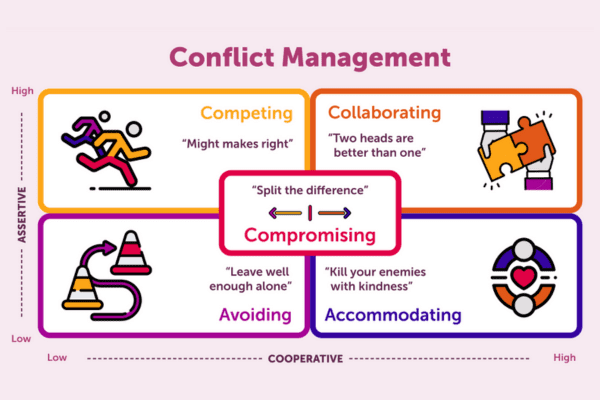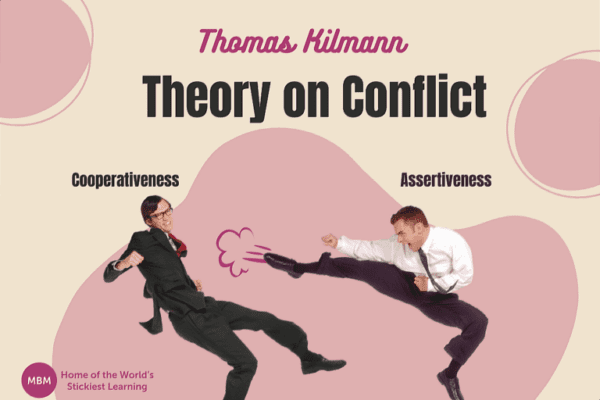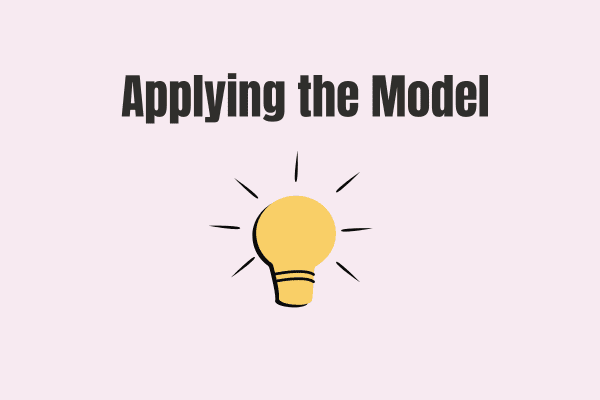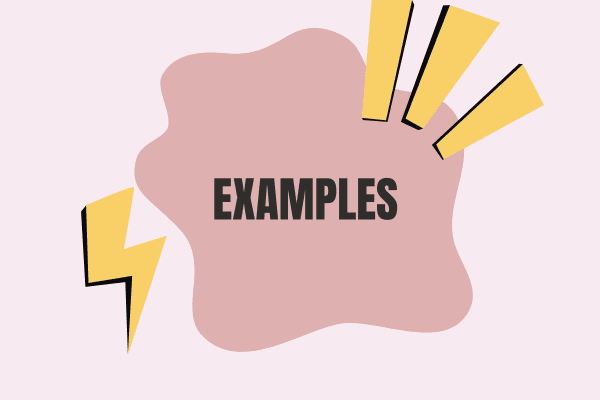A Comprehensive Guide to the Thomas Kilmann Conflict Model
Conflict is natural and unavoidable. But managing it effectively can be a challenge. Luckily, the Thomas Kilmann Conflict Model provides a framework that categorises different conflict-handling styles, helping HR professionals, leaders, and managers understand the responses of their co-workers and employees during such situations. Reasons such as these inspired the development of this model in the 1970s by Dr Thomas and Dr Kilmann, hence its name. With that, let’s explore how you can benefit from using this model today.
Article Overview:
- What is the Thomas Kilmann Theory on Conflict?
- What Are the 5 Thomas Kilmann Conflicts Modes?
- Assessing Your Conflict Management Style
- Advantages and Disadvantages of the Thomas Kilmann Conflict Model
- Real-life Examples of the Thomas Kilmann Conflict Model
- Comparing the Thomas Kilmann Conflict Model to Other Conflict Resolution Models
- Training and Development Programs to Improve Conflict Management Skills
- The Future of the Thomas Kilmann Conflict Model and Its Relevance in Today’s World
- Recap of the Key Practices
Why is the Model Important?
Knowing the Kilmann and Thomas conflict styles can help you better navigate conflicts, interpret behaviours and choose appropriate strategies. For instance, the model illustrates that a ‘collaborating’ approach is ideal for achieving comprehensive, enduring resolutions, whereas a ‘competing’ stance suits scenarios demanding swift, decisive action.
Conversely, an ‘accommodating’ strategy prioritizes harmony preservation over personal agenda, making it invaluable in maintaining organizational cohesion. This model thus equips individuals with insights to effectively manage conflicts and foster productive outcomes.
1) What is the Thomas Kilmann Theory on Conflict?
The Thomas Kilmann Conflict Model is a popular framework for understanding different approaches to conflict resolution. Developed by Kenneth W. Thomas and Ralph H. Kilmann in the 1970s, this model identifies five key conflict management styles based on two underlying dimensions: assertiveness and cooperativeness. Ideally, by assessing their conflict management style and understanding the styles of others, individuals can better deal with conflicts and reach positive outcomes.
Click the image below for a larger version.

So, the Thomas Kilmann Model works with quite a simple format (as seen above) which is a 2×2 matrix using “Assertive” and “Cooperative” as the X and Y axes. In this way, we can have a clear visual of the placing of each of the 5 styles within their levels of each of the axes.
The one style that features in the middle (even levels of Assertive and Cooperative) is the Compromising style. The other four have distinct differentiating levels between the 2 axes. Here are the 4 other combinations that will occur.
- High Assertiveness and Low Cooperativeness = Competition.
- Low Assertiveness and High Cooperativeness = Accommodation.
- Low Assertiveness and Low Cooperativeness = Avoidance.
- High Assertiveness and High Cooperativeness = Collaboration.
Through the article, we will give more explanation about how these combinations work (or don’t) and what to be aware of for best practices.
Well, let’s see those five conflict management styles identified by the Thomas Kilmann Conflict Model again:
- Competing
- Collaborating
- Compromising
- Avoiding
- Accommodating
Each style is characterised by a different level of assertiveness and cooperativeness and can be effective in certain situations but not in others. By understanding these styles, individuals can improve their ability to manage conflicts and achieve positive end results.
2) What Are the 5 Thomas Kilmann Conflicts Modes?

#1- Competing Style
First, the competing style is marked by high assertiveness and low cooperativeness. Individuals who use this style prioritise their own goals and objectives, even if it means ignoring the goals and objectives of others. This style is suitable in situations where:
- Prompt action is required
- A decision needs to be made swiftly
However, overusing this style can cause damaged relationships and reduced trust. Remember, this style is about creating a result that is very much “I win – You lose”.
Examples of Use of the Competing Style
So, let’s have a look at some possible situations where this approach would be the more effective of the 5 to use.
- When you know you are right and the stakes are high, so you need to stand your ground.
- There is a sense of urgency and you need to make a quick decision that doesn’t include input or debate.
- In some cases, people simply want to be right and will not let the conflict go until they are proven right.
#2- Collaborating Style
Next, individuals who utilise the collaborating style demonstrate high levels of assertiveness and cooperativeness. They concentrate on discovering a solution that benefits all parties and achieves their objectives. Ideally, use this style more than others, simply because the style promotes a Win-Win situation.
Examples of Using the Collaborating Style
- When you have mutually similar goals to achieve and can work closely together to get the best results for all involved.
- Negotiating cross-departmental/interpersonal tasks that can be exchanged or delegated for increased productivity and achieving the company/department goals.
#3- Compromising Style
Here, individuals who use the compromising style exhibit moderate assertiveness and cooperativeness. They aim to find a middle ground or compromise that satisfies the needs and objectives of all parties involved partially.
There are a number of mixed advantages and disadvantages that often cancel each other out. The main challenge with this approach is the possibility of appearing indecisive.
Examples of Using the Compromising Style
- When you want to move on to more important tasks and you are willing to meet in the middle to resolve the matter.
- Getting a mutually agreed end result is more important than winning.
- Understanding that to move forward there needs to be give and take on both sides.
#4- Avoiding Style
Now, the avoiding style is characterised by low assertiveness and low cooperativeness. Individuals using this style focus on avoiding conflict altogether, rather than engaging in a potentially difficult or uncomfortable situation.
Ideally, this is the style to stay away from the most. There are so many reasons to steer clear of this approach. Actually, I can’t stress how much it’s important to avoid this a as leader.
Examples of Using the Avoiding Style
- When petty issues are going to take up unnecessary time and effort in terms of results.
- Where you have 1 or more members of the conflict who openly reject any conflict management options and are unwilling to listen, therefore, leading you to postpone the conflict resolution meeting/discussion.
#5- Accommodating Style
Finally, the accommodating style is characterised by low assertiveness and high cooperativeness. Individuals using this style are focused on meeting the needs and goals of others, even if it means sacrificing their own needs and goals.
Examples of Using Accommodating Style
This style may be appropriate in situations where the relationship with the other party is more important than the end result of the conflict, or when the issue is not significant enough to warrant a more assertive approach.
3) Assessing Your Conflict Management Style

Assessing your conflict management style is crucial for effective conflict resolution. By understanding your tendencies and preferences when it comes to managing conflict, you can recognise when your approach may not be working and make necessary adjustments. Furthermore, being aware of your style can help you identify potential areas for growth and improvement.
One common method is to take the Thomas Kilmann Conflict Mode Instrument (TKI), a self-assessment tool that measures an individual’s preferred conflict management style. Other methods may include seeking feedback from colleagues, friends, or family members, or reflecting on past conflicts and considering how you responded in each situation. By taking the time to assess your style and reflect on past experiences, you can develop greater self-awareness and improve your ability to manage conflicts in the future.
Types of Conflict
Conflicts can arise in many different forms, each with its unique impact on individuals and organisations.
#1: Interpersonal Conflict
One type of conflict is interpersonal conflict, which occurs between individuals due to differences in opinions, values, or perceptions. This type of conflict can create tension, anxiety, and stress, and if not managed effectively, it can lead to damaged relationships and decreased productivity.
#2: Organisational Conflict
Another type of conflict is organisational conflict, which can arise due to differences in goals, priorities, or power dynamics. This type of conflict can impact an entire organisation and can result in decreased morale, low job satisfaction, and increased employee turnover. Moreover, if not resolved effectively, organisational conflict can lead to legal issues, financial losses, and damaged reputations. Therefore, it is crucial for individuals and organisations to understand the different types of conflicts and their impact and to develop effective conflict management strategies.
#3: Leadership Conflict
Now, with this type of conflict, you see a couple of different scenarios. First, you have leaders in different departments, who have different approaches, and who create inconsistencies from team to team. We all know that employees talk to one another. As such, the different approaches can create comparisons, and then resentment, when one team compares their leader to others.
Another challenge is when we see leaders within the same area/department confuse the team with contradicting leadership approaches. I have experienced this first-hand. I had a Head of Department who had a very hands-on, cooperative leadership approach. Actually, we all felt included and heard. Then, the Assistant Head of the Department was the absolute opposite style and micromanaged all of us, despite our levels of knowledge, skills, or expertise. It created such levels of confusion and frustration, that we ended up losing some great talent from the team as a result.
#4: Process Conflict
So, this one frustrates us all at different levels. Think of your organisation. Now, think about all of the standards, procedures, and processes to follow. Very often the processes of one area will be in a different sequence to other departments involved. This can lead to major disruption when trying to achieve goals but the processes aren’t in sync.
Applying the Thomas Kilmann Conflict Model in Different Situations

By understanding the different conflict management styles and when they may be appropriate to use, individuals can handle conflicts more effectively and achieve positive end results.
#1: Workplace
One area where the Thomas Kilmann Conflict Model can be particularly useful is in the workplace. Workplace conflicts can arise for various reasons, such as differences in communication styles, goals, or personalities. By using the Thomas Kilmann Conflict Model, individuals can assess their conflict management style and understand the styles of their coworkers or employees. This can lead to more effective communication, increased trust, and improved working relationships.
#2: Personal Relationships
The Thomas Kilmann Conflict Model can also be applied in personal relationships, such as with family members or friends. By understanding each other’s conflict management styles, individuals can approach conflicts with greater empathy and understanding. This can lead to improved communication and stronger relationships. Overall, the Thomas Kilmann Conflict Model provides a valuable framework for managing conflicts in a variety of settings and can lead to more positive outcomes for all parties involved.

Common Challenges in Implementing the Thomas Kilmann Conflict Model
While the Thomas Kilmann Conflict Model provides a valuable framework for managing conflicts, there are common challenges that can arise when attempting to implement the model. By understanding these challenges and developing strategies for overcoming them, individuals can improve their ability to manage conflicts effectively. So let’s explore some of these challenges.
#1: Resistance to Change
One common challenge is resistance to change. Note that implementing the Thomas Kilmann Conflict Model may require individuals to change their approach to conflict resolution, which can be difficult for some people. To overcome this challenge, it is important to communicate the benefits of using the model and provide training and support to individuals as they learn new conflict management strategies.
#2: Cultural Differences
Another challenge is cultural differences. The Thomas Kilmann Conflict Model is based on Western cultural values and may not be appropriate for all cultures or situations. When working with individuals from different cultures, it is important to be aware of cultural differences in communication and conflict resolution styles and to adapt strategies accordingly. This may involve seeking input and feedback from individuals from different cultural backgrounds and modifying the model to better align with cultural values and norms.
4) Advantages and Disadvantages of the Thomas Kilmann Conflict Model

The Thomas Kilmann Conflict Model provides a valuable framework for managing conflicts in a variety of settings. However, like any model, there are both advantages and disadvantages to using the model.
Advantages:
- Increased self-awareness: By using the Thomas Kilmann Conflict Model, individuals can assess their conflict management style and gain a greater understanding of how they approach conflicts. This increased self-awareness can lead to improved communication and more effective conflict resolution.
- Improved communication: The model emphasises the importance of communication and understanding the perspectives of others. By using the model, individuals can develop better communication skills and more effectively convey their perspectives while also understanding the perspectives of others.
Disadvantages:
- Limited scope: The Thomas Kilmann Conflict Model primarily focuses on individual conflict resolution and may not be as effective in addressing larger, systemic issues that may contribute to conflict.
- Cultural bias: The model is based on Western cultural values and may not be appropriate for all cultures or situations. It is important to be aware of cultural differences in communication and conflict resolution styles and to adapt strategies accordingly.
- Over-simplification: The model provides a useful framework for understanding different conflict management styles, but it may oversimplify the complexities of human exchanges and conflict resolution.
5) Real-life Examples of the Thomas Kilmann Conflict Model

To understand how to apply the Thomas Kilmann Conflict Model in different situations, individuals can effectively use real-life examples. Examining how others have utilised the model to manage conflicts can provide insights and strategies for conflict resolution.
- Witness the Thomas Kilmann Conflict Model in action in the workplace as an example.
- Identify the underlying causes and determine the most effective conflict management style to employ when there is an argument or conflict among colleagues. For instance, if the conflict results from a misunderstanding or miscommunication, the collaborating or accommodating style may be the most suitable.
- Apply it in customer service. When customers express dissatisfaction with a product or service, one can use the model to identify their underlying needs and interests and determine the most effective conflict management style to employ. For instance, if the company is at fault, using the accommodating style may be the most effective approach.
Tips:
- Identify the underlying causes of the conflict.
- Consider the needs and interests of all parties involved.
- Determine the most effective conflict management style to use based on the situation.
- Communicate effectively and listen to the perspectives of others.
The Thomas Kilmann Conflict Model enables individuals to manage conflicts in relationships with family or friends in a personal context. For instance, if an individual experiences an argument or conflict with a family member, they can use the model to pinpoint the underlying causes of the conflict and select the most suitable conflict management style. Moreover, the model can help individuals assess their conflict management style and recognise areas for enhancement.
6) Comparing the Thomas Kilmann Conflict Model to Other Conflict Resolution Models
There are other models out there that we want to bring to your attention. Now let’s take a look.
#1: Interest-Based Relational (IBR) Approach
One popular model is the Interest-Based Relational (IBR) approach. The IBR approach focuses on identifying the underlying interests and needs of all parties involved in a conflict and working collaboratively to find a solution that meets the needs of all parties. This approach emphasises the importance of building relationships and trust between parties to effectively resolve conflicts.
While the Thomas Kilmann Conflict Model also emphasises the importance of communication and understanding the perspectives of others, it is more focused on individual conflict management styles rather than collaborative problem-solving.
#2: Harvard Negotiation Model
Another commonly used model is the Harvard Negotiation Model. This model emphasises the importance of:
- Separating people from the problem and focusing on interests rather than positions.
- Generating multiple options for mutual gain and using objective criteria to assess options.
While there are similarities between the Harvard Negotiation Model and the Thomas Kilmann Conflict Model, the Harvard model is more focused on negotiation and finding a mutually beneficial solution, while the Thomas Kilmann model is more focused on individual conflict management styles.
7) Training and Development Programs to Improve Conflict Management Skills
Training and development programs can be a valuable tool for improving conflict management skills using the Thomas Kilmann Conflict Model. These programs can be tailored to the needs of individuals or organisations and can help individuals develop the skills and strategies necessary to effectively manage conflicts.
- Provide individuals with an understanding of the Thomas Kilmann Conflict Model, including the different conflict management styles and when each style is most appropriate. Individuals can also learn how to assess their conflict management style and identify areas for improvement. This can be done through interactive workshops, case studies, and role-playing exercises.
- Give individuals practical strategies for managing conflicts in different situations. This can include strategies for managing conflicts with colleagues, customers, or other stakeholders.
8) The Future of the Thomas Kilmann Conflict Model and Its Relevance in Today’s World
So, where do we go from here? Let’s have a look at how we can continue to apply this model, and potential barriers, to get better results for conflict management.

Potential Applications in New Contexts
The Thomas Kilmann Conflict Model has the potential to be applied in the area of online communication and social media. More and more communication takes place through digital platforms. Conflicts and misunderstandings can arise due to the lack of face-to-face exchange.
Adapting to Changing Social Dynamics
Another challenge for the Thomas Kilmann Conflict Model is adapting to the changing social dynamics of the modern world. Diversity increases and new cultural norms and values can emerge. Hence updating the model may be necessary to account for these changes. This might entail creating new conflict management styles that are more appropriate for the requirements of diverse populations.
The Need for Continued Research and Development
Now, as with any model or theory, ongoing research and development are necessary to ensure its continued relevance and effectiveness. Actually, this is particularly important in the case of the Thomas Kilmann Conflict Model, to keep it relevant and applicable. This is particularly where new insights and best practices can help individuals and organisations better manage conflicts and improve outcomes.
9) Recap of the Key Practices
When all is said and done, we need to apply I.D.E.A.S. when dealing with conflict.

I: Investigate the Cause of the Issue
First, delve deep and find the root causes for issues and conflicts that are happening in your team.
D: Deal with Characters and Personalities
Next, know your team. Be prepared for potential outbursts, etc. that might surface. Remember, you are the leader. As such, you need to be ready to deal with all varieties of personalities and adjust your approach accordingly.
E: Empathy
Here, understand where people are coming from before making a judgment. In fairness, we don’t always know what people are going through. It can truly create great results.
A: Apply a Fair Approach
Ensure that conflict is handled fairly and without prejudice. The worst mistake we can make is going into a conflict situation with our minds already closed to potential new information or taking sides. Stay open and ready.
S: Solutions that Work
Finally, we need to ensure that we have ideas and solutions ready to resolve conflict. Here, we need to be ready to adapt and move between approaches for the best results.
Conclusion & Additional Help
In conclusion, the Thomas Kilmann Conflict Model provides a powerful framework for understanding and managing conflicts in various contexts. With its five conflict management styles and accompanying assessment tools, the model has been widely used by individuals and organisations to improve communication and collaboration and reduce conflict.
Do you want your team to better manage conflict internally and externally? This conflict resolution training course will give you the required skills.
Attention: Subscribe through LinkedIn to know when we publish a new article.
Updated on: January 20, 2024




